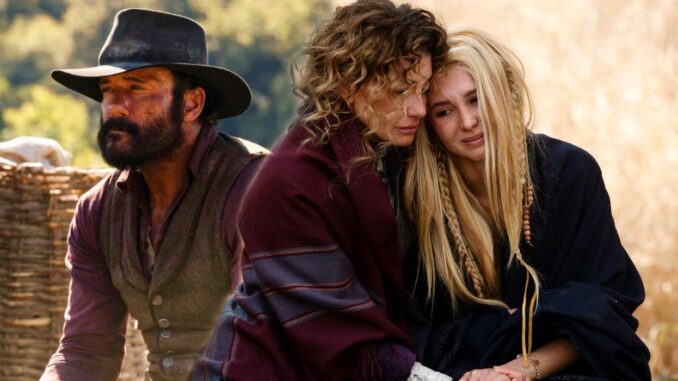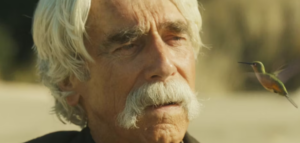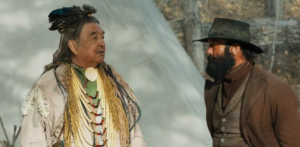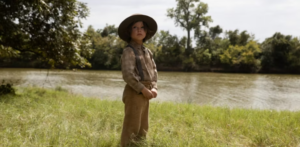
1883 Ending Explained (& Future Yellowstone Shows Setup)
The 1883 ending tied up the 10-episode prequel series to Yellowstone and deftly set up the future of the Dutton family. 1883 tells the tale of how the Duttons came to own the land in Montana which would become the Yellowstone Dutton Ranch. The series centers on James Dillard Dutton (Tim McGraw), his wife Margaret (Faith Hill), their eldest daughter and show narrator Elsa (Isabel May), and Shea Brennan (Sam Elliott) the leader of the wagon train that the Duttons travel with to the American West. The show is set over 135 years before Yellowstone in the franchise timeline.
From the start of 1883, the family faces danger, tragedy, and the thinning of their clan as they head west. The defense of the Yellowstone Dutton Ranch is the top priority for every generation of the family and to see the trials the founders had to go through to acquire it puts the future ranchers’ vigilance in perspective. A promise about the rightful owners of the Dutton land is also made in the 1883 ending, a development that directly impacts 1923, Yellowstone, and beyond.
1883 Tells The Story Of The Dutton Ranch
The Ending Sets Up The Future Bloodshed Over The Duttons’ Land

1883’s ending painted a stark picture of how those who were part of the Westward Expansion survived, loved, and died along the journey. Heartbreakingly, Elsa was mortally wounded and picked the spot in Paradise Valley where she wanted James to bury her. Meanwhile, a year after Josef’s (Marc Rissmann) wife died, and his leg had to be amputated, he finally removed his wedding ring and prepared to rebuild his home. Thomas (LaMonica Garrett) and Noemi’s (Gratiela Brancusi) family also found a spot in Oregon where they settled. Finally, Shea reached the beach, and there, took his own life.
In a mix of tragic death and hopeful optimism for the show’s settlers, the 1883 ending fleshed out the story of how the Yellowstone Dutton Ranch was founded with the blood of pioneers, literally. The site Elsa chose to be buried was a valley called “Paradise” which ended up becoming the Yellowstone Ranch.
Though the Duttons finally made it to the future site of their homestead, it came at the cost of James and Margaret losing their beloved daughter Elsa. The implications of the violence and harshness that resulted in the ranch in the 1883 ending would be felt decades later for future generations of Duttons.
Why Elsa Dutton Had To Die In The 1883 Ending
Elsa Returns To Narrate 1923 Following Her Death
Elsa’s death signaled the end of the first chapter in the story of the Duttons of Yellowstone. Elsa wasn’t just the narrator — she was the very heart and soul of 1883. In short, it was simply time for Elsa to die, which heralded the beginning of an entirely new chapter for the Duttons.
It’s also important to remember how Elsa died: gravely wounded in a violent misunderstanding between the caravan of white settlers and 1883’s band of Lakota warriors. As James and Margaret agreed to settle the land wherever Elsa decided to die, Elsa’s death foreshadowed the tensions between Indigenous American communities and the Yellowstone Dutton Ranch in the present time.
While Indigenous Americans have lived and survived in Paradise Valley thousands of years before 1883’s settlers even set foot in Montana, Elsa’s death showed what the Duttons gave up in order to claim their property — a long, lingering look into the roots of the conflicts that drive the Yellowstone universe.
What The Hummingbird That Joins Shea In The 1883 Ending Means
The Bittersweet End Gives Shea Peace In His Final Moments
By the end of 1883, Shea Brennan fulfilled his personal quest to see the ocean before he died. Amid the crashing of the waves, Shea admired the ocean while remembering his wife, who died of smallpox before the start of 1883. After a hummingbird appeared and hovered around Shea for some time before flying away — implying his wife was there to enjoy the beach with him in spirit — Shea followed through with his plan to shoot himself.
Although Shea’s death is tragic, it’s a rare moment of true peace and fulfillment in 1883, as the tormented character finally gets what he wants. In Indigenous American culture, the hummingbird is a symbol of good luck, which is likely why Shea was moved by the bird’s presence, especially as it appeared during his last moments on Earth. While Shea won’t be needing any luck, the hummingbird’s presence could foreshadow good fortune for the surviving members of the caravan, who each have found their own plots of land to settle in Oregon and Montana.
What Happens To The Dutton Family Ranch After The End of 1883
The Surviving Members Of The Dutton Family Still Faced Danger In The Years To Come
After the 1883 ending that left the Dutton family in mourning, they immediately got to work building what would eventually become the largest ranch in the United States. However, for James and Margaret after 1883, the tragic loss of their daughter, sister, and niece may have hampered their efforts to effectively run the ranch. After only a few years, James was shot and Margaret froze to death.
Their remaining children, John and Spencer, were near death in 1894 when Jacob Dutton (Harrison Ford) arrived at Margaret’s request to save the family and the ranch. However, John Dutton, seen only as a small boy in 1883, is killed as an adult early in 1923, making Spencer Dutton the only surviving member of the original Dutton family.
How The 1883 Ending Spoiled The Finale Of Yellowstone Season 5
The Final Moments Of 1883 Set Up The Franchise’s Overarching Narrative

The Indigenous man who helped Elsa is also the one who told James about Paradise Valley. Moreover, James and the man’s conversation also potentially foreshadowed events in Yellowstone season 5. While the man pointed James to the future site of the Yellowstone Dutton Ranch, he followed up by saying, “but know this: in seven generations, my people will rise up and take it back from you.” James replies, “In seven generations, you can have it.”
The Dutton Ranch in Yellowstone is called a seven-generation ranch by Governor Lynelle Perry. The implication here is that John Dutton’s children, or possibly even Tate Dutton — Kayce and Monica’s half-white, half-Indigenous son — could end up giving their land back to the Broken Rock Indian Reservation in Yellowstone season 5.
How 1883’s Ending Set Up Yellowstone Spinoff 1923
Set Decades Later, 1923 Shows The Dutton Ranch Is Still In Peril

The explosive premiere episodes of Paramount’s Yellowstone spinoff 1923 revealed the respective fates of James and Margaret after the 1883 ending. Though James and Margaret founded the ranch, they failed to make it a thriving business, and they eventually both died, with James succumbing to gunshot wounds from an encounter with horse thieves and Margaret freezing to death.
Fortunately, as Elsa narrated in 1923, Margaret wrote to James’ family for help. This was what prompted James’ brother, Jacob Dutton, to come to the ranch, turn it into a successful business, and raise James and Margaret’s children as his own. The 1883 ending, explained from the context of the beginning of 1923, bridges the first 40 years of Yellowstone Ranch history.
1883 ended with revealing how the Yellowstone Dutton Ranch was founded and the story of how the Duttons carved Paradise Valley into the largest contiguous cattle ranch in America continues in 1923. Apart from how the ranch operated under the watch of Jacob and Cara Dutton (Helen Mirren), 1923’s true story-inspired plot sees the Yellowstone universe once again diving deep into America’s dark past, showing what goes on inside Indigenous American boarding schools and how white pioneers fought each other to survive Montana’s harsh early century.
Every Other Yellowstone Spinoff (& If They Connect To The 1883 Ending)
1883 Doesn’t Only Set Up Yellowstone
